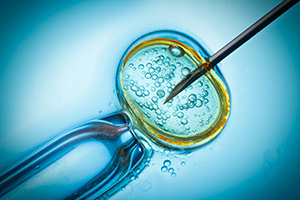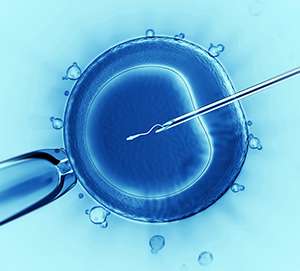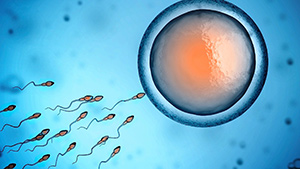 PIXY is a modern method of molecular biological analysis of genetic material, which makes it possible to select the most viable spermatozoa for ICSI. The quality of selection of healthy male germ cells plays an important role in artificial insemination. The method of additional sperm selection affects the development of the embryo and the likelihood of its implantation into the uterine wall after implantation into the female body.
PIXY is a modern method of molecular biological analysis of genetic material, which makes it possible to select the most viable spermatozoa for ICSI. The quality of selection of healthy male germ cells plays an important role in artificial insemination. The method of additional sperm selection affects the development of the embryo and the likelihood of its implantation into the uterine wall after implantation into the female body.
PIXY - what is it?
The PIXY procedure is used to fertilize a mature egg of the most viable sperm without defects. It is used to improve the quality of intracytoplasmic injection and the chances of successful fusion of haploid cells. PIXY differs from IVF in that the conjugation of the genetic material of the male and female germ cells occurs using a needle, and not a test tube, with which the sperm is injected into the oocyte.
 Using this method allows you to solve many problems associated with infertility in men:
Using this method allows you to solve many problems associated with infertility in men:
- low concentration of sperm in the ejaculate (oligozoospermia);
- lack of seminal fluid (aspermia);
- low sperm motility (asthenozoospermia);
- the practical absence of sperm in the ejaculate (cryptozoospermia);
- pathological change in the morphology of most sperm (teratozoospermia).
This technique is also used when the patient has a retrograde ejaculate ejection, in which he does not enter the seminal canals, but enters the bladder. For the implementation of ICSI, only one mature and most healthy spermatozoon is selected using selective selection, which is called PIXI.
The essence of the PIXY method
 Many couples who are faced with the problem of infertility ask themselves the question: "PIXY with IVF - what is it?" This technique is used to maximize the approximation of the selection process of high-quality sperm to natural conditions. During natural conception, complex mechanisms are responsible for the fertilization of the oocyte with full-fledged sperm.
Many couples who are faced with the problem of infertility ask themselves the question: "PIXY with IVF - what is it?" This technique is used to maximize the approximation of the selection process of high-quality sperm to natural conditions. During natural conception, complex mechanisms are responsible for the fertilization of the oocyte with full-fledged sperm.
After ejaculation, the sperm travel a long way from the cervical canal to the fallopian tube, which contains the egg. It can be fertilized by only one sperm, which "reached" the ampulla of the fallopian tube very first. In other words, the oocyte is fertilized by the most active and healthy sperm.
Differences between IVF and PIXY
During IVF, the above biological mechanism is not taken into account, since fertilization takes place in a test tube, which contains many spermatozoa. During the procedure, the female reproductive cell can merge with any of the sperm. In this regard, the quality of the obtained embryos and their viability decrease.
PIXY mimics the process of natural selection of male germ cells and its binding to the oocyte membrane. In laboratory conditions, the reproductive specialist selects the highest quality sperm, which will subsequently fertilize the eggs.
Differences between PIXY and ICSI
What is the difference between ICSI and PIXI? Both procedures involve the selection of the most viable sperm for fertilization of the egg. But PIXY is a more accurate method of selecting male germ cells. With its help, specialists manage to bring the selection of spermatozoa outside the female body as close as possible to natural selection.
Indications for PIXY
 The introduction of PIXI into the practice of artificial insemination has become a real breakthrough in the treatment of infertility in men. Indications for PIXI are:
The introduction of PIXI into the practice of artificial insemination has become a real breakthrough in the treatment of infertility in men. Indications for PIXI are:
- low sperm counts;
- unsuccessful IVF with ICSI;
- frequent spontaneous abortions;
- male infertility of unknown etiology;
- high index of fragmentation of genetic material.
This procedure has significantly increased the chances of successful conception in patients suffering from various reproductive disorders.
How is PIXY performed?
The PIXY fertilization procedure is carried out in several stages:
- Injection of sperm into the PIXY bowl. For sperm collection, PIXY cups made of polymer material are used. Drops of hyaluronic acid are applied to their walls, which plays an important role in the selection of functionally competent male germ cells within the female body;
- Sperm collection. On the head of the sperm there are receptors that are sensitive to hyaluronate. The process of their development completely coincides with the maturation of the reproductive cell itself. In other words, there is a direct relationship between the sensitivity of the sperm to hyaluronic acid and the degree of its maturity. For fertilization of the egg, only those sperm are selected that most actively interact with hyaluronate;
- Fertilization of the egg. Using a very thin glass needle, the selected sperm is injected into the egg under the observation of an inverted microscope. With the successful fusion of male and female genetic materials, a diploid cell (zygote) is formed;
- Growing the embryo. In the above described way, the reproductive specialist fertilizes several eggs at once, after which they are cultured in a nutrient medium for 3 or 5 days. Then the specialist selects the most viable embryos, which are inserted into the uterus using a long catheter.
Medical research proves that sperm selection with sodium hyaluronate increases the chances of fertilization of oocytes, the normal development of the diploid cell and its implantation into the uterine wall after transplantation.
Conclusion
PIXY is the most efficient method of artificial selection of functionally competent sperm. The technology makes it possible to select the best spermatozoa for fertilization of the egg, which have the correct DNA packaging and are free from defects. This technique increases the chances of successful fertilization, conception and intrauterine development of the embryo by at least 35%.

